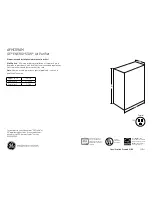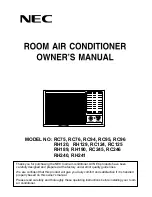
5
English
5.
Carry out complete cooling/thermal insulation of water piping and
outdoor dehumidification. If complete cooling or thermal insula-
tion has not been carried out, any damage may be caused during
severe winter due to freezing, in addition to thermal loss.
6.
When you stop operation during night or winter, it is necessary to
take measures to prevent water related circuits from natural freez-
ing in the area the ambient temperature drops below 0°C (by water
drain off, keeping the circulation pump running, warming up by a
heater, etc.) Freezing of water related circuits may result in any
damage to the plate type heat exchanger. Therefore, please take
appropriate measures depending on the circumstances of use.
(Refer to figure 7)
1.
Example of piping
2.
Water inlet piping
3.
Strainer (sold separately as an accessory)
4.
Air discharge plug (for joint use with cleaning port)
5.
Cleaning device
6.
Strainer for pump
7.
Automatic air discharge valve
8.
Water outlet piping
9.
Joint use with water draining plug
10.
Plate type heat exchanger
11.
Outside unit
7-2 Before starting a test run
1.
Before starting a test run, please make sure that the piping work
has been carried out in a proper manner. Especially, make sure
that the strainer, air discharge valve, automatic water supply valve,
expansion tank and cistern are positioned at their places correctly.
2.
After water has been completely filled in, first run the pump only,
and then make sure that no air has been caught in the water cir-
culation system and the water flow rate is correct. If any air has
been caught or the flow rate is not enough, the plate type heat
exchanger may freeze. Measure any water pressure loss before
and after the outside unit and make sure that the flow rate is as
designed. In case of any abnormal, stop the test run immediately
and carry out trouble shooting to resolve the trouble.
3.
Following the installation manual, carry out a test run of the out-
side unit.
4.
After the test run has been completed, inspect the strainer at the
inlet piping of the outside unit. Clean it if it is dirty.
7-3 Daily service and maintenance
1.
Management of water quality
The plate type heat exchanger has a structure that does not permit
dismantling and cleaning, or replacing any parts. Please pay atten-
tion carefully to the quality of water to be used for the plate type
heat exchanger in order to prevent corrosion and sticking of scale.
The water to be used for the plate type heat exchanger should have
at least the quality as specified in the table below.
When using any corrosion prevention agent, scale depressant
agent, etc, such agent should have no corrosive features against
stainless steel and copper.
2.
Management of chilled water flow rate
If the chilled water flow rate is not enough, it will result in the freez-
ing damage to the plate type heat exchanger. Check for any clog-
ging of the strainer, any air being caught, any reduction in the flow
rate due to failure of circulation pump by measuring the tempera-
ture and pressure differences at the inlet and outlet ports of the
plate type heat exchanger. If the aged difference in the tempera-
ture or pressure has increased beyond the proper range, the flow
rate should have decreased. Stop the operation and remove the
cause before restarting the operation.
3.
Steps to be taken when a freezing protection device was activated
When the freezing protection device should be activated during
operation, remove the cause without fail before restarting the
operation. If the freezing protection device has been once acti-
vated, a partial freezing has occurred. If you restart the operation
without removing the cause, the plate type heat exchanger will be
closed and the ice cannot be melted, and in addition, the freezing
process will be repeated resulting in any damage to the plate type
heat exchanger, leading to any such accidents that the refrigerant
starts leaking or water starts entering the refrigerant circuit.
7-4 Water quality
Water quality standards for chilled water, hot water and make-up
water (4) (6)
[NOTES]
(1) The circle marks in the columns for corrosion or scale to develop.
(2) Corrosion has a tendency to occur when water temperature is
high (40°C or higher), and if metals with no protective coating
whatever are directly exposed to water, it would be a good idea to
take effective measures against corrosion such as adding a cor-
rosion inhibitor or deaeration treatment.
(3) In a condenser water circuit that uses a closed cooling tower, the
closed circuit circulating water and make-up water must satisfy its
water quality standards for the hot water system, and passing
water and make-up water must satisfy those for the circulation
type cooling water system.
(4) The supply water must be clean tap water, industrial water or
clean underground water.
Do not use purified or softened water.
(5) The fifteen items in the table above represent typical causes of
corrosion and scale.
(6) Once through water may cause corrosion.
Do not use once through water.
7-5 Maintenance of plate type heat exchanger
The performance of a plate type heat exchanger may decline due to
scale accumulation. It may be damaged by freezing due to the drop
of flow rate. For this reason, it is necessary to carry out programmed
maintenances at a regular interval in order to prevent the scale from
being generated.
1.
Before entering the season for use, carry out the following
inspections:
1) Conduct a water quality test and make sure that it is within the
standard.
2) Clean the strainer.
3) Make sure that the flow rate is correct.
4) Make sure that the operational conditions (pressure, flow rate,
outlet temperature, etc.) are normal.
Item (5)
Cooling water system (3)
Hot water system (2)
Tendency (1)
Circulation system
Circulation
water
Make-up
water
Circulation
water
(20°C ~
60°C)
Make-up
water
Corrosion Scale
Standard items
pH(25°C)
6.5 to 8.2
6.0 to 8.0
7.0 to 8.0
7.0 to 8.0
{
{
Electrical Conductivity
(mS/m)(25°C)
Less than
80
Less than
30
Less than
30
Less than
30
{
{
Chloride ions
(mgcl
–
/L)
Less than
200
Less than
50
Less than
50
Less than
50
{
Sulfate ions
(mgSO
4
2-
/L)
Less than
200
Less than
50
Less than
50
Less than
50
{
Acid consumption
(pH4.8)
(mgCaCO
3
/L)
Less than
100
Less than
50
Less than
50
Less than
50
{
Total hardness
(mgCaCO
3
/L)
Less than
200
Less than
70
Less than
70
Less than
70
{
Calcium hardness
(mgCaCO
3
/L)
Less than
150
Less than
50
Less than
50
Less than
50
{
Ionic-state silica
(mgSiO
2
/L)
Less than
50
Less than
30
Less than
30
Less than
30
{
Reference items
Iron (mgFe/L)
Less than
1.0
Less than
0.3
Less than
1.0
Less than
0.3
{
{
Copper (mgCu/L)
Less than
0.3
Less than
0.1
Less than
1.0
Less than
0.1
{
Sulfate ion
(mgS
2-
/L)
Shall not
be
detected
Shall not
be
detected
Shall not
be
detected
Shall not
be
detected
{
Ammonium ion
(mgNH
4
+
/L)
Less than
1.0
Less than
0.1
Less than
0.3
Less than
0.1
{
Residual chlorine
(mgCl/L)
Less than
0.3
Less than
0.3
Less than
0.25
Less than
0.3
{
Free carbon dioxide
(mgCO
2
/L)
Less than
4.0
Less than
4.0
Less than
0.4
Less than
4.0
{
Stability index
6.0 to 7.0
—
—
—
{
{
01_EN_3P153897-8L.fm Page 5 Friday, July 11, 2008 5:04 PM
Summary of Contents for VRV-WIII
Page 22: ...3P153897 8L EM08A055 0808 HT...








































